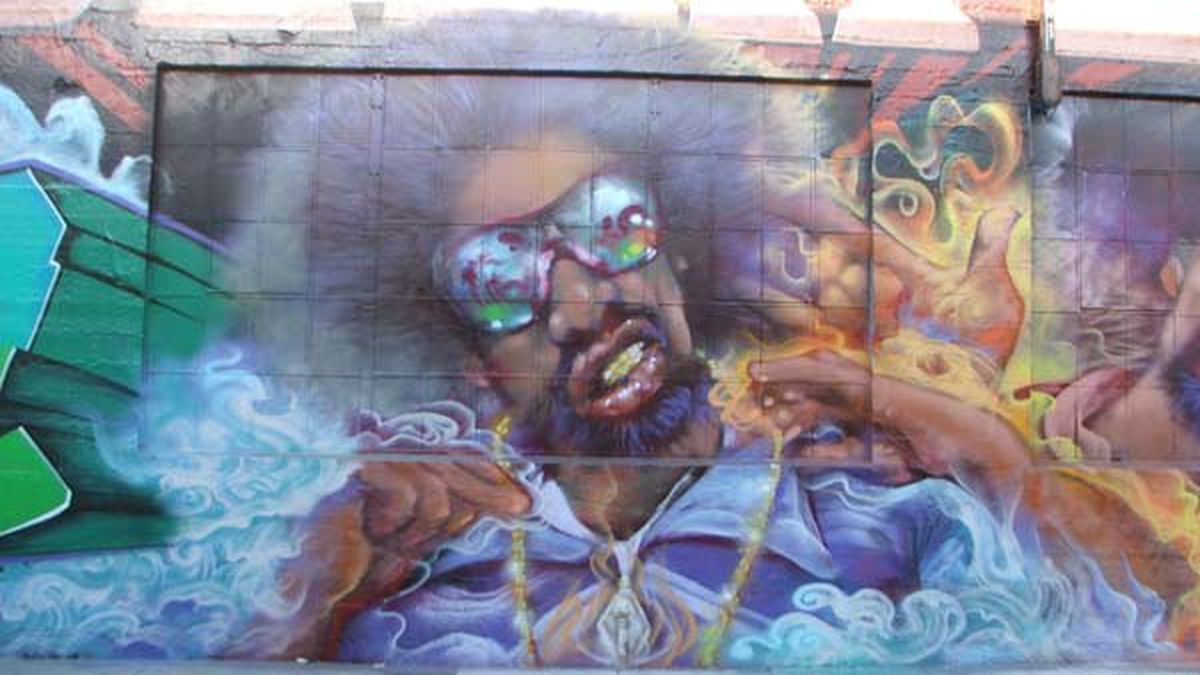Close 2 tha edge
With more than 22 albums released over a span of thirteen years, Mac Dre will go down in history as one of the most creative, prolific, and imaginative rappers ever to touch a microphone. Dre was both new-school and old-school, as well as a major influence on hyphy; his roots go back to late-’80s and early-’90s “mobb music.” Here’s a sampling of the late rapper’s most definitive songs:
“Black Buck Rogers,” (from Heart of a Gangsta, Mind of a Hustler, Tongue of a Pimp, 2000)
Represents: Space-age mackin’ at its finest, as Dre states, He’s tryna have plenty in the new millenie.
Significance: Dre’s visionary status is confirmed by the use of the word “hyphy” six years before the rest of the country heard of it.
“Feelin’ Myself,” (from Ronald Dregan: Dregonomics, 2004)
Represents: Dre at his most humorous. Who else would make a reference to Don Knott’s character Mr. Furley from the ’70s sitcom Three’s Company?
Significance: Dre had a lot of underground favorites that went over with his beloved “cuddies,” but a perfect blend of unique lyricism, verbal game, and a funky beat makes this one truly deserving of wider appreciation. A classic.
“Dredio,” featuring Mac Mall and E-40 (from Da U.S. Open, 2005)
Represents: Old-school appreciation (the beat reprises the ’80s electrofunk anthem “Radioactive”) meets new-school hustle.
Significance: Sadly, this posthumously released track is the only song one-time rivals Dre and E-40 appear together on.
“2 Hard 4 the Fuckin’ Radio,” (from Young Black Brotha: The Album, 1993)
Represents: An archetypical Mac Dre/Khayree production — state of the art in ’93, legendary now. Up-tempo beats, Chaka Khan samples, and lyrics like 18, makin’ hits ‘til I’m 80 though made a strong case that Dre was, in fact, deserving of airplay.
Significance: Ironically, this became a KMEL staple only after Dre’s untimely death.
“Stupid Doo Doo Dumb,” (from Stupid Doo Doo Dumb, 1998)
Represents: One of Dre’s first stabs at comedic humor. The line, when you’re in your own ‘hood and they ask where you’re from, is deep on a number of levels when you really think about it.
Significance: Stupid Doo Doo Dumb was the first solo album Dre dropped after being released from jail. It took him a while to complete his reinvention, but looking back, all the elements were there from day one.
“Rapper Gone Bad,” (from Rapper Gone Bad, 1998)
Represents: Another notch on the comeback trail for Dre. Anyone sleeping on his lyrical skills should check Dre’s sublime gift for punch lines: I’m a dapper rapper who stay fitted like a mannequin/see me in the traffic and say, damn, there go that man again.
Significance: With his second album in less than a year, Dre was definitely stepping up his work ethic after being out of the rap game for four and a half years. Like much of his later work, this Lev Berlak-produced track has an old-school feel.
“She Neva Seen,” (from The Genie of the Lamp, 2004)
Represents: Dre had a seemingly unlimited supply of pimp metaphors, and on this game-laced track, he shows why he earned the ‘hood equivalent of a psychology degree many times over.
Significance: By the time this album rolled around, the Thizz era was in full swing, and Dre was firmly in control of both his image and his marketing. The ghetto-ass album covers of earlier days had been replaced by professional-looking graphics, while the fluttering guitar on this T.D. Camp track makes this song one of Dre’s most musically rewarding efforts.
“California Livin’,” (from Young Black Brotha: The Album, 1993)
Represents: Another early Mac Drizzle favorite that was big in the streets and at house parties back in the day.
Significance: Three years before Tupac’s double album All Eyez on Me, Dre dropped this 21-track slice of uncut game. Looking back today, it’s nothing less than a historical document of Northern California lifestyles of the savage and mannish in the ’90s.
“Gumbo,” Featuring JT tha Bigga Figga, Dangerous Dame, and Da Unda Dog. (from The Rompalation, 1997)
Represents: Dre’s first project without longtime producer Khayree, and the first Romp Records release.
Significance: Dre was one of the most active collaborators in California; The Rompalation was released at the height of mobb music’s compilation phase, after Herm, D-Shot, and Master P’s similarly-thick-with-guests efforts, but before the game got flooded with subpar product. On this track, Dre pays homage to his Southern roots while cooking up a potent lyrical stew.
“Thizzelle Dance,” (from Thizzelle Washington, 2002)
Represents: Dre stepped into the shoes of yet another guffaw-worthy character, the spectacled, ecstasy-popping nerd Thizzelle Washington, and came up with a song so funky, it even has its own dance.
Significance: Dance songs, from “The Hokey Pokey” to “The Humpty Dance” and “Lean Wit It, Rock Wit It,” are part of a storied cultural tradition, and Dre really hit his stride on this one, which hints at the influence the rave scene had on urban music. Thizzelle’s affected English accent on the chorus (Can you do the Thizzelle dance?) adds a touch of comedic pomp to what will surely be regarded as an all-time Bay classic.













